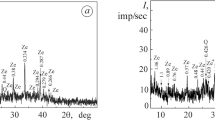Abstract
We have established that strontium chromate and a mixture of modified zinc phosphate and calcium-containing pigment inhibit substantially the corrosion of low-carbon steel in slightly acid rain solution. We observed mainly the anodic control of corrosion in the extract of chromate pigment and mixed control in the extract of a mixture of nonchromate pigments. Zinc ions in corrosive media enhance significantly the protective action of this pigment mixture. Here, a crystal-like protective film, consisting of calcium and zinc phosphates, is formed on the surface of steel. The extracts of chromate pigment and a mixture of nonchromate pigments in a slightly acid medium increase the resistance of low-carbon steel to corrosion fatigue in the stages of crack initiation and growth. Thus, the necessary prerequisites are created for enhancing the service life of steel constructions with organic coatings, containing inhibiting pigments, under conditions of the joint action of a corrosive medium and cyclic loading.
Similar content being viewed by others
REFERENCES
I. M. Zin, S. B. Lyon, and V. I. Pokhmurskii, “Corrosion control of galvanized steel using a phosphate/calcium ion inhibitor mixture,” Corros. Sci., 45, 777–788 (2003).
Acid Rain. A Review of the Phenomenon in EEC and Europe. A Report Prepared for the Commission of the European Communities, Graham & Trofman Ljm, Brussels (1983).
T. C. Simpson, H. Hampel, G. D. Davis, et al., “Evaluation of the effects of acidic deposition on coated steel substrates,” Progress in Organic Coatings, 20, 199–207 (1992).
G. W. Walter, “A critical review of the protection of metals by paints,” Corros. Sci., 26, No.1, 27–38 (1986).
J. H. W. De Wit, “Inorganic and organic coatings,” in: P. Marcus and J. Oudar (editors), Corrosion Mechanisms in Theory and Practice, Marcel Dekker, New York (1995), pp. 581–628.
J. M. Bloom, “Single-edge crack in rectangular sheet subjected to end rotations,” Trans. ASME, Ser. E: Appl. Mech., 33, No.3, 243–246 (1966).
V. I. Pokhmurskii, N. M. Kundrat, L. M. Bilyi, et al., “On the constancy of the stress intensity factor at the tip of a crack in the course of its propagation in a rectangular plate,” Probl. Prochn., No. 12, 59–62 (1984).
N. M. Belyaev, Strength of Materials [in Russian], Gostekhizdat, Moscow (1958).
R. E. Peterson, Stress Concentration Factors. Charts and Relations Useful in Making Strength Calculations for Machine Parts and Structural Elements, Wiley, New York (1974).
H. M. Savin and V. I. Tul’chii, Handbook on Stress Concentration [in Ukrainian], Vyshcha Shkola, Kiev (1976).
Y. Tanizawa and T. Suzuki, “Effects of silicate ions on the formation and transformation of calcium phosphates in neutral aqueous solutions,” J. Chem. Soc. Faraday Trans., 91, 3499–3503 (1995).
T. Olesen, T. Steenberg, E. Christensen, and N. J. Bjerrum, “Electrolytic deposition of amorphous and crystalline zinc-calcium phosphates,” J. Mater. Sci., 33, 3059–3063 (1998).
I. Mayer and J. D. B. Featherstone, “Dissolution studies of Zn-containing carbonated hydroxyapatites, ” J. Crystal Growth, 219, 98–101 (2000).
F. J. G. Cuisinier, P. Steuer, J. C. Voegel, and I. Mayer, “Structural analyses of carbonate containing apatite samples related to mineralized tissues,” J. Mater. Sci.: Materials in Medicine, 6, 85–89 (1995).
Y. Tanizawa, K. Sawamura, and T. Suzuki, “Reaction characteristics of dental and synthetic apatites with Fe2+ and Fe3+ ions,” J. Chem. Soc. Faraday Trans., 86, 1071–1075 (1990).
V. V. Panasyuk and L. V. Ratych, “The methodology of estimating inhibitor effectiveness in corrosion fatigue crack propaga-tion,” Corrosion, 37, No.3, 391–412 (1995).
I. M. Dmytrakh and V. V. Panasyuk, Effect of Corrosive Media on the Local Fracture of Metals near Stress Concentrators [in Ukrainian], Karpenko Physicomechanical Institute, Lviv (1999).
Author information
Authors and Affiliations
Additional information
__________
Translated from Fizyko-Khimichna Mekhanika Materialiv, Vol. 40, No. 5, pp. 31–36, September–October, 2004.
Rights and permissions
About this article
Cite this article
Zin’, I.M., Bilyi, L.M., Gnyp, I.P. et al. Protective Action of Phosphate and Calcium-Containing Pigments under the Conditions of the Stress Corrosion Fracture of Steels. Mater Sci 40, 605–610 (2004). https://doi.org/10.1007/s11003-005-0088-8
Received:
Published:
Issue Date:
DOI: https://doi.org/10.1007/s11003-005-0088-8




